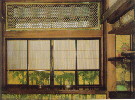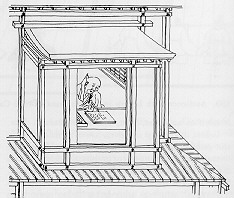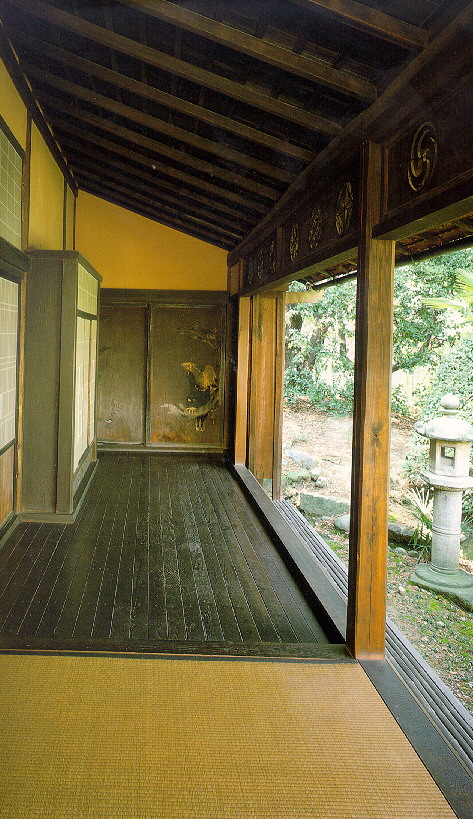


 The
tsukeshoin (writing or desk alcove), as described by Ito Teiji as "the
framed alcove with four shoji placed on the side of the tokonoma in the
manner of modern shoin architecture. The alcove was built around a wooden
desk or bench-like structure." The tsukeshoin most likely dates back to
the Kamakura period, since it appears in many picture scrolls of the late
13th and 14th early Centuries, as illustrated in The Pictoral Biography
of the Monk Honen. Then, the functional, serving as a space on which
on could read or write, however, accounts tell us that it was used as another
surface of display. Similar to the chigai-dana's function of displaying
books or tea utensils, specific items were also displayed in the tsukeshoin.
Generally these items were writing implements like: a water jar, pitcher,
brush tray, short knife, seal case, and scrolls, as catalogued in 1430
in a kaisho of one of the sub temples at Daigoji. By 1511, the Kundaikan
socho-ki tea ceremony manual, it was recorded that the shoin decoration
was completely standardized. As we see it today the original function of
the space has been lost.
The
tsukeshoin (writing or desk alcove), as described by Ito Teiji as "the
framed alcove with four shoji placed on the side of the tokonoma in the
manner of modern shoin architecture. The alcove was built around a wooden
desk or bench-like structure." The tsukeshoin most likely dates back to
the Kamakura period, since it appears in many picture scrolls of the late
13th and 14th early Centuries, as illustrated in The Pictoral Biography
of the Monk Honen. Then, the functional, serving as a space on which
on could read or write, however, accounts tell us that it was used as another
surface of display. Similar to the chigai-dana's function of displaying
books or tea utensils, specific items were also displayed in the tsukeshoin.
Generally these items were writing implements like: a water jar, pitcher,
brush tray, short knife, seal case, and scrolls, as catalogued in 1430
in a kaisho of one of the sub temples at Daigoji. By 1511, the Kundaikan
socho-ki tea ceremony manual, it was recorded that the shoin decoration
was completely standardized. As we see it today the original function of
the space has been lost.
[Main Page]
[Development]
[Functions]
[Features]
[Display Elements]